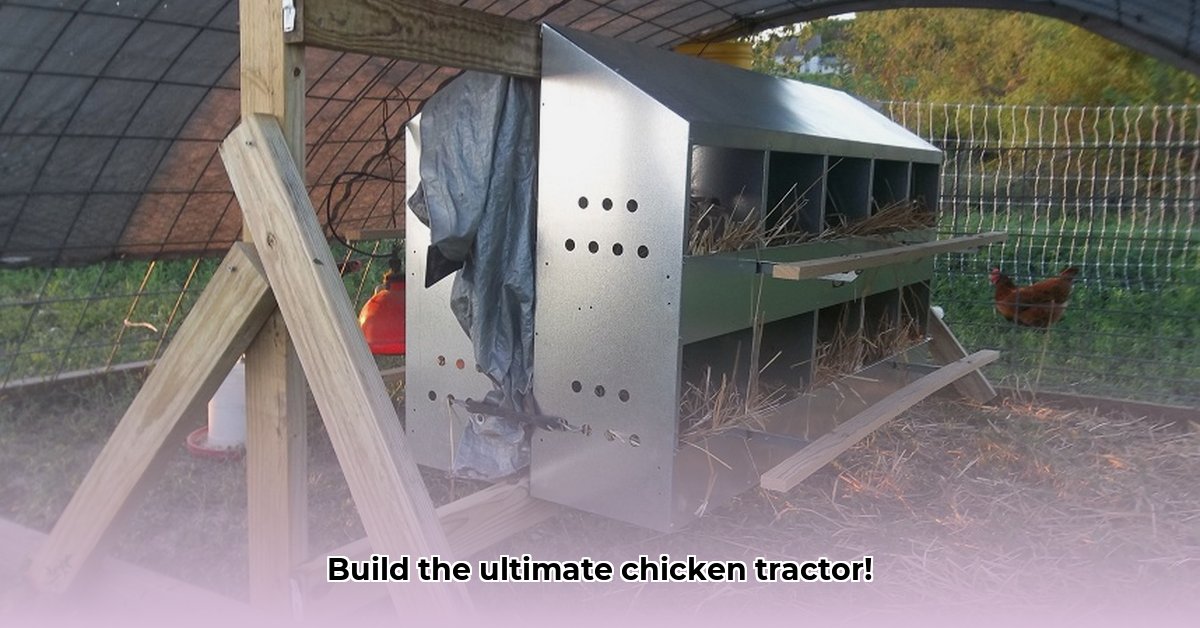
Pre-fab vs. DIY: Choosing the Right Chicken Tractor
Building a chicken tractor offers a sustainable and rewarding way to raise chickens, providing fresh eggs and enriching your soil. But the method of acquisition – pre-fabricated or DIY – significantly impacts cost, time commitment, and customization. Which approach best suits your needs?
For more on coop sizing, check out this helpful resource on chicken tractor dimensions.
This comparative review analyzes the key differences between pre-fabricated and DIY chicken tractors, helping you make an informed decision. A quick glance at the significant variables reveals different levels of investment: a pre-fabricated model demands a higher initial outlay, while a DIY project requires a larger time commitment and specific skills. However, both methods offer a unique set of advantages. Let's delve deeper into the specifics.
| Feature | Pre-fabricated Coop | DIY Chicken Tractor |
|---|---|---|
| Upfront Cost | Higher | Lower (but more labor intensive) |
| Customization | Limited | Highly Customizable |
| Assembly Time | Minimal | Significant time investment |
| Hens Capacity | Typically smaller (3-4 hens) | Potentially larger (up to 20+) |
| Maintenance | Generally easier | Requires more regular upkeep |
| Mobility | Usually designed for easy movement | Depends entirely on your design |
Consider this: Are you a novice chicken keeper with limited time and a desire for a quick setup? A pre-fabricated coop might be ideal. Do you enjoy DIY projects, have carpentry skills, and want a highly customized solution? A DIY tractor offers unparalleled flexibility.
Designing Your Own Chicken Tractor: A Step-by-Step Guide
Building your own chicken tractor allows for complete customization. This detailed guide walks you through the process, emphasizing critical design considerations for a successful project.
Step 1: Planning & Design
Before building, create a detailed plan. Consider flock size (how many chickens?), desired materials (wood is common, but metal offers durability), and essential features (nesting boxes, roosting bars, secure doors, and a robust mobility system). Thorough planning significantly reduces errors and frustration during construction.
Step 2: Construction
Numerous free online plans offer various complexities and designs. Choose a plan that aligns with your skill level. Prioritize constructing a strong, weather-resistant structure that protects your hens from predators. Using quality materials directly impacts longevity and safety.
Step 3: Nesting Boxes
Integrate easily accessible nesting boxes. The number of boxes depends on your flock size and individual hen preferences. Ensure adequate ventilation to maintain a healthy environment within the nesting boxes. Poor ventilation can lead to ammonia buildup, harming your hens.
Step 4: Mobility System
Incorporate durable wheels or runners for easy pasture rotation. Consider your terrain; larger, sturdy wheels are essential for uneven ground. This is crucial for both hen health and pasture management.
Step 5: Finishing Touches
Once complete, apply a protective coat of paint or stain. This adds durability and enhances aesthetics. Remember weatherproofing; this is essential for years of use.
Maintaining Your Chicken Tractor: Key Practices for Longevity
Regular maintenance is crucial regardless of whether you opted for a pre-fabricated or DIY tractor.
- Regular Cleaning: Consistent manure removal prevents ammonia buildup and minimizes disease risk. A clean coop means a healthy flock.
- Thorough Inspections: Inspect for damage (gnaw marks, rotted wood). Prompt repairs prevent structural issues and maintain predator deterrence.
- Wheel/Runner Maintenance: Lubricate moving parts and replace worn components to ensure smooth mobility.
The Benefits of Mobile Coops: Beyond Fresh Eggs
Rotating your chicken tractor brings significant advantages beyond egg production.
- Improved Pasture Health: Rotating prevents overgrazing, allowing pasture recovery, and enriches the soil with manure.
- Parasite Reduction: Regular relocation disrupts parasite lifecycles, promoting hen health and reducing disease risk.
- Natural Fertilization: Hen manure acts as natural fertilizer, reducing the need for chemical fertilizers.
- Enhanced Predator Protection: Frequent relocation makes it harder for predators to target your flock.
How to Choose a Mobile Chicken Coop for Sustainable Farming: Key Takeaways
- Chicken tractors provide a sustainable poultry farming method, improving soil health and decreasing reliance on commercially produced feed.
- The choice between pre-built or DIY depends on budget, available skills, and time constraints.
- Careful consideration of design factors such as size, materials, and predator protection is vital for a successful setup.
- Implement rotational grazing to optimize pasture usage and prevent overgrazing. This practice is crucial for long-term farm sustainability.
Addressing Potential Risks: A Proactive Approach
Successfully using a mobile chicken coop involves managing potential hazards.
- Predator Attacks: Robust construction, secure mesh, and possibly electric fencing effectively minimize this risk.
- Disease Outbreaks: Maintain coop cleanliness and practice biosecurity (that is, control of infectious agents). Consult a veterinarian if necessary.
- Market Fluctuations: Diversify income streams (selling eggs, meat, compost) to mitigate economic uncertainties.
By carefully considering these factors, you can effectively integrate a mobile chicken coop system into your agricultural practices. This improves soil quality, ensures hen well-being, and results in delicious, homegrown eggs.